WEE Technology Company Limited - WEE are Capacitors Specialist
WEA 2000H at 85C Snap in Aluminum Electrolytic Capacitors For Speaker
Network
https://www.weetcapacitor.com/Datasheet/WEET-WEA-2000H-at-85C-Snap-in-Aluminum-Electrolytic-Capacitors-For-Speaker-Network.pdf
WEA2C222M03500500100BR
2200uF 160V D*L: 35*50mm low ESR: 72mOhm Ripple Current: 4.5mA
WEA2K182M03500500100BR
1800uF 180V D*L: 35*50mm low ESR: 88mOhm Ripple Current: 4.1mA
WEA2D152M03500500100BR
1500uF 200V D*L: 35*50mm low ESR: 106mOhm Ripple Current: 3.8mA
WEA2E122M03500450100BR
1200uF 250V D*L: 35*45mm low ESR: 166mOhm Ripple Current: 3.4mA
WEA2E681M03500500100BR
680uF 250V D*L: 35*50mm low ESR: 293mOhm Ripple Current: 2.6mA
WEA2G471M03000500100BR
470uF 400V D*L: 30*50mm low ESR: 423mOhm Ripple Current: 2mA
WEA2W561M03500500100BR
560uF 450V D*L: 35*50mm low ESR: 355mOhm Ripple Current: 2.4mA
WEA2H471M03500600100BR
470uF 500V D*L: 35*60mm low ESR: 423mOhm Ripple Current: 2.6mA
Other popular serie snap in ecaps:
WEB - 2000H at 105°C Snap in
https://www.weetcapacitor.com/Datasheet/WEET-WEB-2000H-at-105C-General-Snap-in-Aluminum-Electrolytic-Capacitors.pdf
WEC - 5000H at 85°C Snap in
https://www.weetcapacitor.com/Datasheet/WEET-WEC-5000H-at-85C-Long-Life-Miniaturized-Snap-in-Aluminum-Electrolytic-Capacitors.pdf

WEE Technology Company Limited - WEE are Capacitors Specialist
WEET provides the best capacitor suited for diversifying customer needs. Top Class, high reliability, long life, low impedance and high ripple current Aluminum Electrolytic Capacitors. Wide variety of SMT aluminum electrolytic capacitors in the industry. Fully covers the needs of the SMD aluminum electrolytic capacitor market.
Application Guide:
Aluminum electrolytic capacitors (electrolytics) are widely used in power supply applications requiring high capacitance in energy-dense, small-volume packages having very low equivalent series resistance (ESR).
Strong Series SMD E-cap Aluminum Electrolytic Capacitors:
WXS - SMD E-cap 85°C 2000Hours, Standard
Cross Reference: UWX (Nichicon), SC (Samwha), SEV (Rubycon) , MVA (CHEMI-CON)
WXT - SMD E-cap 105°C 2000Hours, Wide Temperature
Cross Reference: UWT (Nichicon), RC (Samwha), SKV (Rubycon), MVE (CHEMI-CON)
WLZ - SMD E-cap 105°C 2000Hours, Low Impedance
Cross Reference: WF (Nichicon), CK (Samwha), TZV (Rubycon), MZA/MVY (CHEMI-CON)
WFZ - SMD E-cap 105°C 3000-5000Hours, Extra Lower Impedance
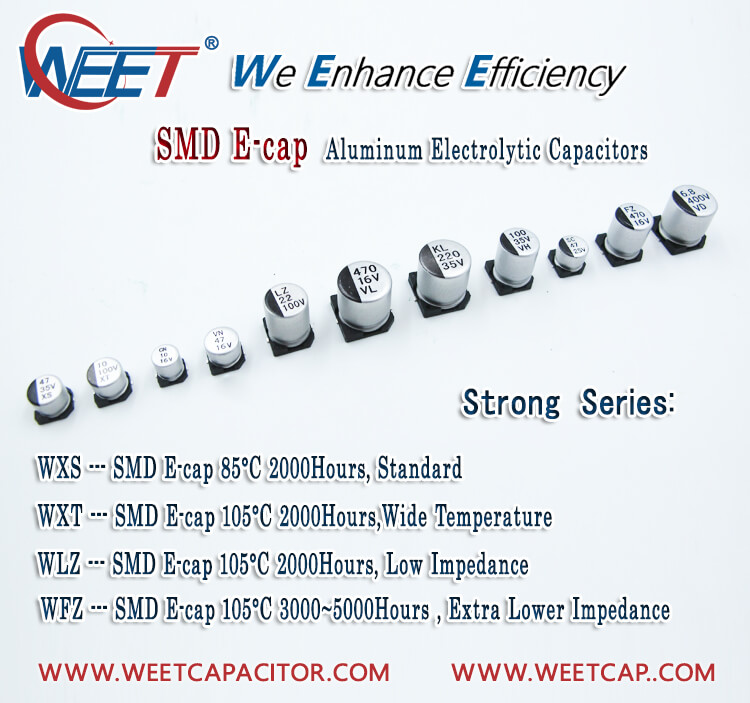
WEET Aluminum Electrolytic Capacitors Surface Mount SMD Type High Voltage 125C SMD Electrolytic Capa
WEE Technology Company Limited - WEE are Capacitors Specialist
SMD SMT Chip Aluminum Electrolytic Capacitors
Temperature: 85°C, 105°C, 125°C
Load Life: 1000Hours, 2000Hours, 3000Hours, 5000Hours
WXS - 2000H at 85°C Standard
WXT - 2000H at 105°C Standard
WCN - 1000H at 105°C BP
WVN - 2000H at 105°C NP
WLZ - 2000H at 105°C
WVL - 3000H at 105°C
WKL -5000H at 105°C
WVH - 2000H at 125°C
WSC -2000H at 105°C
WFZ -5000H at 105°C
WVD - 5000H at 105°C
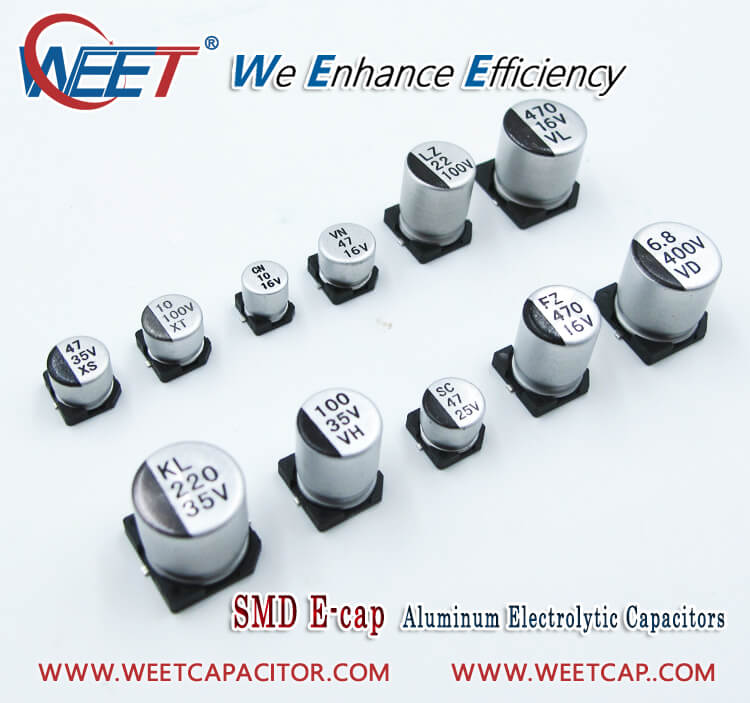
WEET LOW ESR Long Life Screw Lug Snap in Terminal Aluminum Electrolytic Capacitors Cross Reference C
WEE Technology Company Limited - WEE are Capacitors Specialist
WEET
Aluminum Electrolytic Capacitors are good alternatives for CDE, KEMET,
Panasonic, Rubycon, United Chemi-Con (or Nippon Chemi-Con), Nichicon...
There is a wide selection of standard and custom screw, lug, snap-in terminal and board mount smd capacitors.
Cross CD135:
WEET WED CD135 2000H at 85C Miniaturized Screw Aluminum Electrolytic Capacitors
Datasheet: https://www.weetcapacitor.com/Datasheet/WEET-WED-CD135-2000H-at-85C-Miniaturized-Screw-Aluminum-Electrolytic-Capacitors.pdf
Cross CD136:
WEET WEF CD136 2000H at 105C High Ripple Current Screw Aluminum Electrolytic Capacitors
Datasheet: https://www.weetcapacitor.com/Datasheet/WEET-WEF-CD136-2000H-at-105C-High-Ripple-Current-Screw-Aluminum-Electrolytic-Capacitors.pdf
Comparison of non-solid and solid types:
Aluminum
electrolytic capacitors are divided into two sub-types depending on
whether they make use of liquid or solid electrolyte systems.
Aluminum electrolytic capacitors with non-solid electrolyte:
may
use a liquid electrolyte based on ethylene glycol and boric acid,
so-called "borax" electrolytes, or based on organic solvents, such as
DMF, DMA, GBL, or based on high water containing solvents, for so-called
"low impedance", "low ESR" or "high ripple current" capacitors.
Aluminum electrolytic capacitors with solid electrolyte:
have
a solid manganese dioxide electrolyte, it's solid aluminum capacitor
(SAL), or a solid polymer electrolyte, it's polymer aluminum
electrolytic capacitor, or hybrid electrolytes, with both a solid
polymer and a liquid, it's also polymer aluminum electrolytic capacitor.
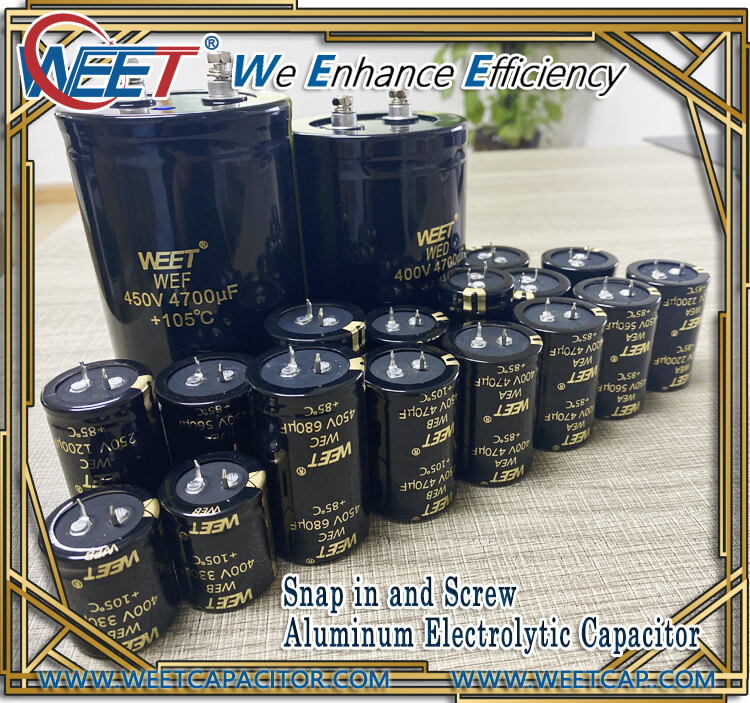
WEET Large Can Aluminum Electrolytic Capacitors Screw Terminal and Snap in Type 2000H to 5000H 85C a
WEE Technology Company Limited - WEE are Capacitors Specialist
What are aluminum electrolytic capacitors used for?
Aluminum electrolytic capacitors (electrolytics) are widely used in power supply applications requiring high capacitance in energy-dense, small-volume packages having very low equivalent series resistance (ESR).
What is considered a large capacitor?
The capacitance of a capacitor tells you how much charge it can store, more capacitance means more capacity to store charge. The standard unit of capacitance is called the farad, which is abbreviated F. It turns out that a farad is a lot of capacitance, even 0.001F (1 milifarad -- 1mF) is a big capacitor.
WEF - 2000H at 105°C Screw
WEET WEF CD136 2000H at 105C High Ripple Current Screw Aluminum Electrolytic Capacitors
WED - 2000H at 85°C Screw
WEET WED CD135 2000H at 85C Miniaturized Screw Aluminum Electrolytic Capacitors
WEA - 2000H at 85°C Snap in
WEET WEA 2000H at 85C Snap in Aluminum Electrolytic Capacitors For Speaker Network
WEB - 2000H at 105°C Snap in
WEET WEB 2000H at 105C General Snap in Aluminum Electrolytic Capacitors
WEC - 5000H at 85°C Snap in
WEET WEC 5000H at 85C Long Life Miniaturized Snap in Aluminum Electrolytic Capacitors
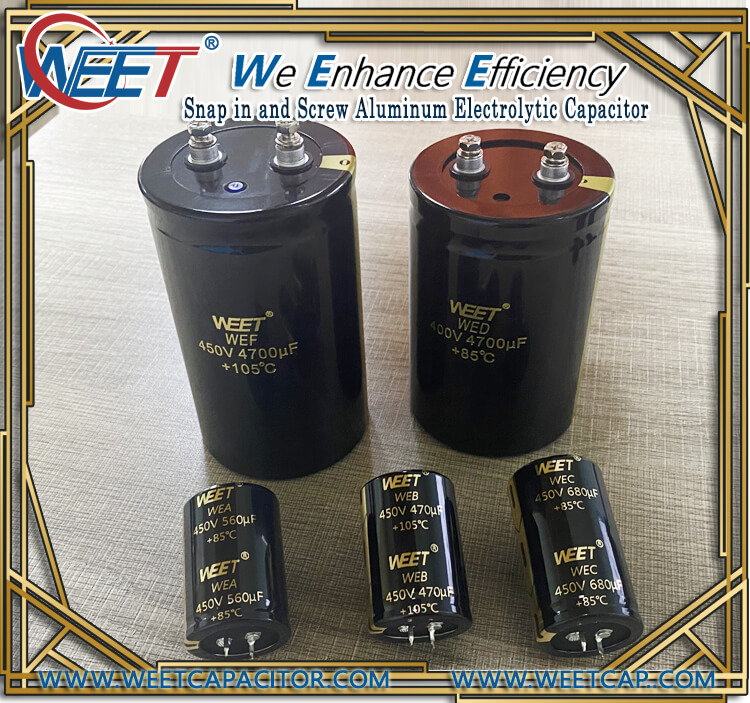
WEE Technology Company Limited - WEE are Capacitors Specialist
WEET WEF 4700uF 450V 105℃ Ultrasonic,Welding machine capacitor energy saving lamp capacitor downsized, Screw, 105℃ 2,000 hours
WEET's Aluminum Electrolytic capacitors offer excellent ripple current carrying capability coupled with extended life for high energy and power applications.
Series Description+105°C, General Purpose
Series Category: Aluminum Electrolytic Capacitors
Series Type: Screw Type
Series Applications: Professional Inverters and Power Supplies
Series Capacitance Range: 220 - 33000 µF
Series Voltage Range: 25 - 100 VDC & 160 - 450 VDC
Series Operating Temperature Range: -40 - 105 ºC & -25 - 105 ºC
Terminal Type: Screw Terminal
Load Life (in hours): 2000
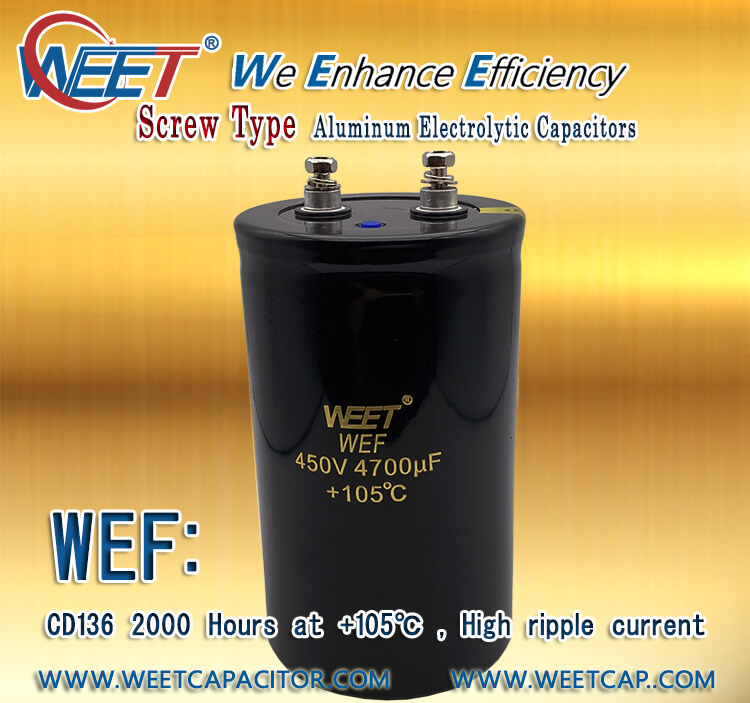
WEE Technology Company Limited - WEE are Capacitors Specialist
400V 4700uF Screw Electrolytic Capacitor (CD135) 85℃ Standard, 2000 hours, Screw terminal Type (Large Can)
WEET WEE Technology manufacture and supply CD135 can aluminum electrolytic capacitor, CD135 Screw aluminum electrolytic capacitor, 85C Standard Screw aluminum electrolytic capacitor, UPS aluminum electrolytic capacitor
WEET WED CD135 Series Screw aluminum electrolytic capacitor Characteristics:
Capacitance Range: 270uf -820000uf
Capacitance Tolerance (20℃ , 120Hz): +-20%
Operating Temperature Range (C):
- 40℃ - +85℃ Rated Voltage (V): 10-250 VDC
-25℃ - +85℃ Rated Voltage (V): 350-450 VDC
Applications:For UPS, Drive, Inverter& Power Supplies
ROHS Compliant
Rated Voltage: 10V, 16V, 25V, 35V, 50V, 63V, 80V, 100V, 160v, 200V, 250V, 350V, 400V, 450V
Capacitance: 270uf, 330uf, 390uf, 470uf, 560uf, 680uf, 820uf, 1000uf, 1200uf, 1500uf, 1800uf, 2200uf, 2700uf, 3300uf, 3900uf, 4700uf, 5600uf, 6800uf, 8200uf, 10000uf, 12000uf, 15000uf, 18000uf, 22000uf, 27000uf, 33000uf, 39000uf, 47000uf, 56000uf, 68000uf, 82000uf, 100000uf, 120000uf, 150000uf, 180000uf, 220000uf, 270000uf, 330000uf, 390000uf, 470000uf, 560000uf, 680000uf, 820000uf
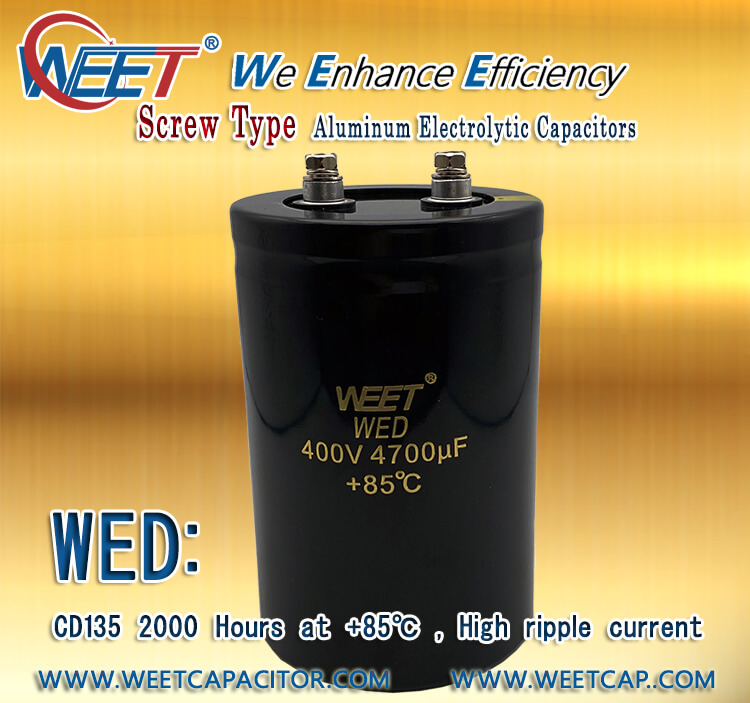
WEE Technology Company Limited - WEE are Capacitors Specialist
WEET WEC 5000 Hours 85C Snap in aluminum electrolytic capacitor cross to CD295 Jianghai Industrial Capacitors Miniaturized Size and Long Life
So what is WEC long life snap in E-cap applications?
In most applications, aluminum electrolytic capacitors – as poled devices – are used with a DC voltage bias of proper polarity with some superimposed AC voltage.
Meanwhile, how to distinguish general purpose grade and long life grade capacitors?
Aluminum electrolytic capacitors are generally divided into two basic reliability categories: capacitors for high-reliability applications and capacitors for general-purpose applications.
This differentiation has also been adopted in the relevant IEC standards.
In IEC publications aluminum electrolytic capacitors for high-reliability applications are identified as "Long-Life Grade" capacitors. The abbreviation( LL )is stamped on the capacitors.
Aluminum electrolytic capacitors for general applications are called "General-Purpose Grade" (GP) in IEC publications.
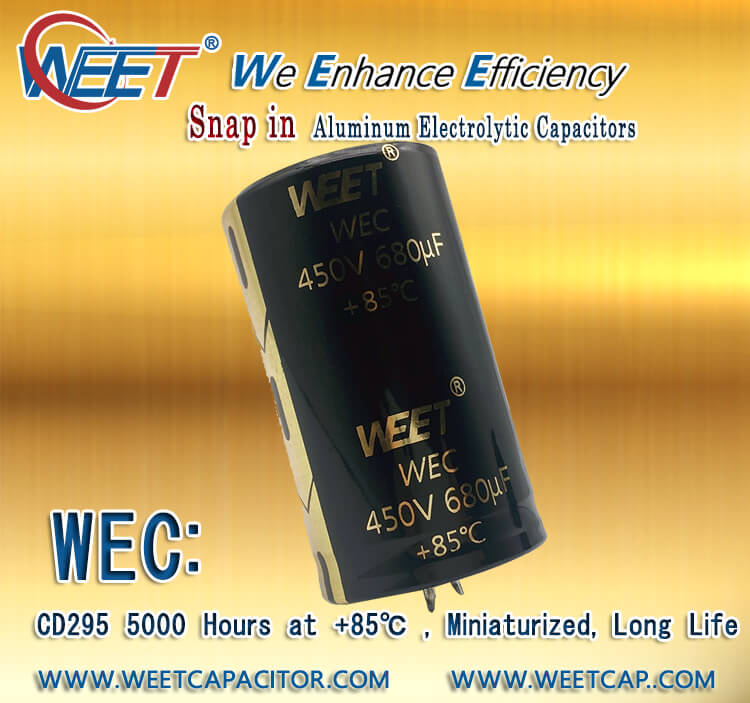
WEE Technology Company Limited - WEE are Capacitors Specialist
WEB - 2000H at 105°C, Miniaturized, Snap-in Aluminum Electrolytic Capacitor Features
Load life of 2000 hours at 105°C
High ripple current
Smaller size
PCB Mounting
Cross reference to https://www.jbcapacitors.com/Aluminum-Electrolytic-Capacitors/JNE-Snap-in-105-Miniaturized-Aluminum-Electrolytic-Capacitor.html
Electrolytic capacitor is a kind of capacitor. The metal foil is the positive electrode (aluminum or tantalum), and the oxide film (alumina or tantalum pentoxide) close to the positive electrode is the dielectric. The cathode is composed of conductive material, electrolyte (electrolyte can be liquid or solid) and other materials. Because electrolyte is the main part of the cathode, electrolytic capacitor gets its name. At the same time, the positive and negative of electrolytic capacitor should not be wrongly connected.
Aluminum electrolytic capacitors can be divided into four categories: lead aluminum electrolytic capacitor; Snap in aluminum electrolytic capacitor; Screw aluminum electrolytic capacitor; solid aluminum electrolytic capacitor.
![]()
WEE Technology Company Limited - WEE are Capacitors Specialist
450V 560uF 85℃ Snap in Aluminum Electrolytic Capacitors
CD293 2000Hrs 85℃ Snap in electrolytic capacitor.
CD293 Series Snap in aluminum electrolytic capacitor, 85℃ Standard Snap in aluminum electrolytic Capacitors
Typical applications include general purpose power electronics, UPS, SMPS, and battery chargers.
Snap Mount Caps usually mount on a PCB (printed circuit board).
Maximum Operating Temperature: : 10V-400V(-40℃~ +85℃); 450V-500V(-25℃ ~ +85℃)
Number of Pins: : 2 Pins, 4 Pins
Voltage : 10V, 25V, 16V, 35V, 50V, 63V, 80V, 100V, 160V, 180V, 200V, 250V, 350V, 400V, 450V,500 V
Cross Reference: Epcos (B41231), Nippon Chemi-Con(SMQ), Nichicon(LS), Panasonic (TS-UQ), Samwha(HC), Kendeil(K26), Yageo(LH), DAEWOO(FHS)

